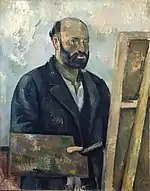Marie-Hortense Fiquet
Marie-Hortense Fiquet Cézanne (22 April 1850 – 1922) was a French artists' model. She is best known for her marriage to Paul Cézanne and the 27 portraits, mostly in oil, he painted of her between 1869 and the late 1890s.[1]
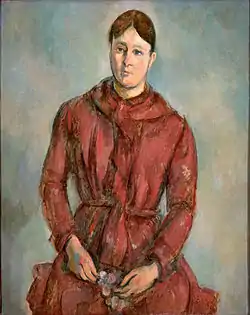
Life
She was born in Saligney, France on 22 April 1850. In 1869, she met Cézanne at an art school in Paris called Académie Suisse. This art school was used by a number of major artists as a place to meet each other and to paint the models who worked there. Fiquet's main job was as a bookseller or bookbinder, but she combined this with part-time work as a model. They started a relationship and when the Franco-Prussian War broke out in 1871, they left Paris together for L'Estaque in the south of France. Afraid of offending his father, Louis-Auguste Cézanne, a well-to-do banker, and compromising his allowance, he went to great lengths to conceal his liaison with Fiquet. The existence of their child Paul, born in 1872, was kept from Louis-Auguste for some years.[2]
Fiquet and Cézanne married on 28 April 1886, in the presence of the artist's parents, though by that time he had publicly said that he no longer had any feelings for her. Described by one scholar as "high-maintenance", Fiquet was to live separately from her husband for much of their married life.[3] After the death of Louis-Auguste Cézanne that same year, Cézanne and his wife separated, the artist moving in with his sister and mother and declaring, "My wife only cares for Switzerland and lemonade".[2] The psychological distance between husband and wife appears to be reflected in the portraits where she gives the impression of being self-absorbed.[4]
She eventually settled in Paris.[5] Although he continued to paint his wife until the 1890s, he disinherited her. After her husband's death in 1906, their one child, Paul (1872–1947) inherited his father's entire estate. The settlement that Hortense received from her son was squandered through gambling.[6]
In literature
Hortense may have provided inspiration for a character in L'Œuvre, an Émile Zola novel which appeared in serial form the year before the Cézannes' marriage. Zola was a friend to Cézanne from their schooldays, although the novel caused some tension between them.[7]
In the novel, Christine, also a model, marries a painter. However the book is not biographical in the strict sense; while the fictional painter bears some relation to Cézanne, Christine poses nude, a far cry from Cézanne's chaste portraits of Fiquet, and more reminiscent of Le déjeuner sur l'herbe by Édouard Manet.[8]
Gallery
_in_a_Red_Dress%252C_oil_on_canvas%252C_116.5_x_89.5_cm%252C_The_Metropolitan_Museum_of_Art%252C_New_York.jpg.webp)
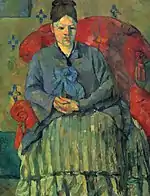 Madame Cézanne in a red armchair, 1877. Museum of Fine Arts, Boston
Madame Cézanne in a red armchair, 1877. Museum of Fine Arts, Boston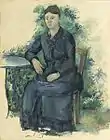 Madame Cézanne in a Garden, 1879-1880, Musée de l'Orangerie
Madame Cézanne in a Garden, 1879-1880, Musée de l'Orangerie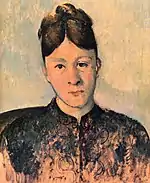 Portrait of Mme Cézanne, c. 1885
Portrait of Mme Cézanne, c. 1885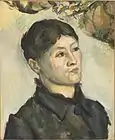 Portrait of Madame Cézanne, 1885, Philadelphia Museum of Art
Portrait of Madame Cézanne, 1885, Philadelphia Museum of Art Portrait of Marie-Hortense Fiquet, 1885–1887, Musée Granet
Portrait of Marie-Hortense Fiquet, 1885–1887, Musée Granet Madame Cézanne, c. 1886, Oil on canvas, The Detroit Institute of Arts
Madame Cézanne, c. 1886, Oil on canvas, The Detroit Institute of Arts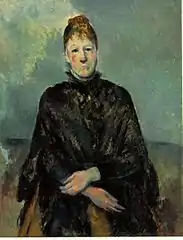 Portrait of Madame Cézanne, (1885–1887) Barnes collection
Portrait of Madame Cézanne, (1885–1887) Barnes collection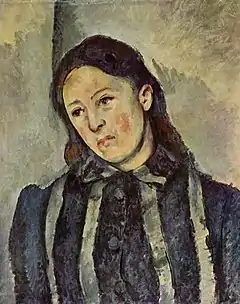
 Madame Cézanne in Blue, 1890, Museum of Fine Arts, Houston
Madame Cézanne in Blue, 1890, Museum of Fine Arts, Houston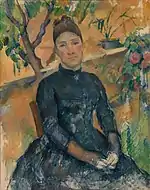 Madame Cézanne in the Greenhouse, 1891–1892. Metropolitan Museum of Art
Madame Cézanne in the Greenhouse, 1891–1892. Metropolitan Museum of Art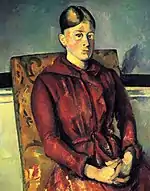 Portrait of Mme Cézanne in a yellow armchair, 1893–1895
Portrait of Mme Cézanne in a yellow armchair, 1893–1895.jpg.webp) Woman in a Green Hat. Madame Cézanne, 1894–1895. Barnes Foundation
Woman in a Green Hat. Madame Cézanne, 1894–1895. Barnes Foundation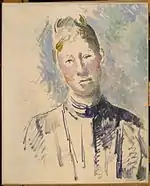 Madame Cézanne, 1885–87. Solomon R. Guggenheim Museum
Madame Cézanne, 1885–87. Solomon R. Guggenheim Museum
References
- Cohen, Patricia. "Author Gives Voice to Artists’ Silent Muses, Their Wives". New York Times, September 3, 2008
- Lindsay
- Laura Gascoigne, Carpenter of Colour, The Spectator, 8 July 2006
- Susan Sidlauskas, Emotion, Color, Cézanne1 (The Portraits of Hortense)
- https://www.geni.com/people/Marie-Hortense-C%C3%A9zanne/6000000011207612933
- Ruth Butler, Hidden in the Shadow of the Master: The Model-Wives of Cézanne, Monet, and Rodin. Yale University Press, 2008.
- "Cézanne and I (Cézanne et moi): The relationship of painter Paul Cézanne and novelist Émile Zola".
- This painting was posed by Manet's wife Suzanne.
Sources
- Garb, Tamar. The Painted Face, Portraits of Women in France 1814–1914. Yale University Press, 2007. ISBN 978-0-300-11118-7
- Lindsay, Jack. Cézanne: His Life and Art. Greenwich, Connecticut: New York Graphic Society, 1969
External links
| Wikimedia Commons has media related to Marie-Hortense Fiquet. |
